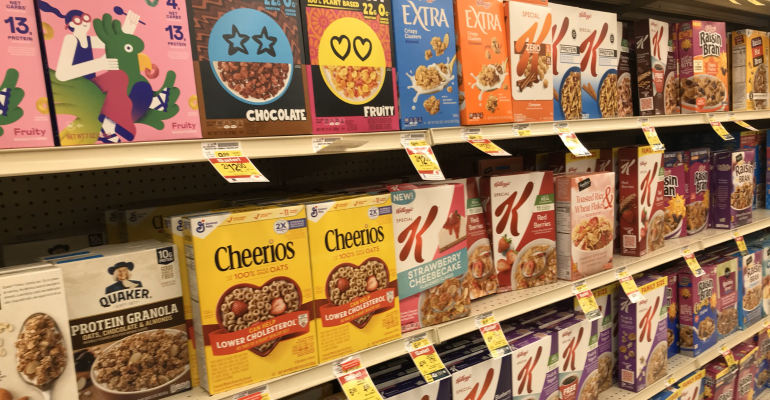Higher prices and evolving consumer eating habits are creating obstacles — and opportunities — for merchandisers of center store breakfast foods.
While cereal remains the most popular item, unit sales decreased 5.4% for the 52 weeks ending Jan. 28, with an average price of $4.37, a 9.6% gain, reports Circana, a Chicago-based market research firm.
Unit sales were also down for shelf-stable toaster pastries/tarts (-5.1% with an 8.6% average price increase), and pancake/waffle mixes (-1.7% and a 9.3% price gain). All other shelf-stable breakfast foods, including ready-to-drink meals, instant breakfast, wheat germ, and dried food, had a 13.1% sales decline with a 5.2% price increase.
“Amid inflation and price concerns, the percentage of cereal eaters who cite ‘making something that fits into my budget’ has shot up from just 4% in 2019 to 10% at the end of 2023,” said Brian Kurilla, research supervisor, studio/syndicated, for CivicScience, Inc., a Pittsburgh-based consumer research firm. Thirty-seven percent of shoppers also indicate they consider price when considering what cereal to buy.
In addition to cost, 73% of Americans list flavor and taste as the most important factors when choosing a breakfast cereal, and 32% of cereal buyers consider nutritional content, such as sugar and fiber, CivicScience reports, adding that 35% of the consumers who prepare breakfast cite making something quickly as the biggest breakfast challenge.
While 29% of adults say they regularly eat cereal or oatmeal for breakfast, consumption typically decreases with age. Gen Z adults (ages 18-24) consume the most cereal, with 67% eating it at least once or twice per week, compared to 45% of Baby Boomers (aged 55 and up), CivicScience reports.
Offer bargains
“Center store breakfast food shoppers are looking for convenience and deals,” said Bridget Allerton, director, business development consulting, for 84.51°, a Cincinnati-based research and insights firm and a unit of The Kroger Co. “They are more likely to buy other convenience items and pay below the average price compared to the average shopper.”
Because the shoppers also tend to have larger households with children, “expect them to be looking for deals more often,” Allerton said, adding that 75% of respondents in a survey indicated that deal searching is the main action they will take to offset price increases.
Retailers, in turn, will likely trigger greater breakfast sales, said Sally Lyons Wyatt, Circana executive vice president and practice leader. “Consumers want deals and value, but it’s all about the right deals, the right brand, the right pack size, and the right price points,” she said. “We are still in an inflationary period and while prices are softening, consumers are looking for deals that matter. Retailers should do trial and testing to see what works with shoppers and sticks.”
Changing consumer buying patterns will impact center store breakfast purchasing as well, analysts said. Foods that enable quick and convenient eating and benefit the growing base of work-at-home consumers who are returning to the office are becoming especially popular, Wyatt said.
Alterations to daily commutes and work-from-home policies also are accelerating shifts in mealtimes, which includes an increase in the merging of breakfast and lunchtimes, said Melanie Torres Cabrera, research analyst for Euromonitor International, a London-based market research firm.
She said economic downturns also are increasing interest in center store selections, but many consumers are moving away from traditional products. More shoppers, for instance, are seeking customizable items, including the “on-the-go friendly nature of muesli and granola” instead of children’s breakfast cereals, Cabrera said.
Nevertheless, many homes with children are continuing to use cereals as a quick, low-effort meal to energize kids at the start of their day, Cabrera said. “However, as prices continue to rise across all lifestyle segments, supermarkets are facing increasing challenges from club stores like Costco, which are a convenient one-stop shop for a variety of home needs.”
Shopper skepticism is another roadblock to the purchase of shelf-stable breakfast foods in supermarkets, she said. “Between erratic lifestyles and the rising cost of living, consumers are increasingly seeing breakfast as an option or want, and not a need,” she said. “Additionally, consumers are facing conflicting information on health trends within the breakfast space. Despite industry efforts to increase nutritional claims in cereals, many consumers remain influenced by social media warnings against ultra-processed foods stripped of nutrients.”
Emphasize flexibility
Retailers can widen interest in breakfast foods by positioning products as versatile and convenient beyond breakfast time, Cabrera said. She suggested offering convenient pack sizes that are resealable and easy to hold, and selections that consumers can snack on or combine with other items throughout the day. “While shoppers aren’t explicitly looking to replace meals, living conditions are challenging consumers and industries to adapt pantry items against evolving mealtimes,” she said.
Merchandisers also should enhance the value perception of breakfast foods and make it easier to shop, find, and purchase items in store and online, Allerton said. “Personalize value to distinct household groups, especially households with kids, omni-commerce households, and households who prioritize convenience and price,” she said. “It is important to understand and address unique household needs through assortment, offers, and communication when delivering value to center-store breakfast shoppers.”
While the typically lower price of store brands is an appealing element to many cost-conscious breakfast shoppers, it still is important for retailers to offer a solid combination of private label and national selections, Wyatt said.
“Consumers like to feel they are getting a deal and will be looking for anything that will help them manage their wallets better,” Wyatt said. “But national brands bring fun, excitement, innovation, and differentiation. People want to have an experience in the home because it is so expensive to eat out. National brands bring that little extra premium that many people can afford.





